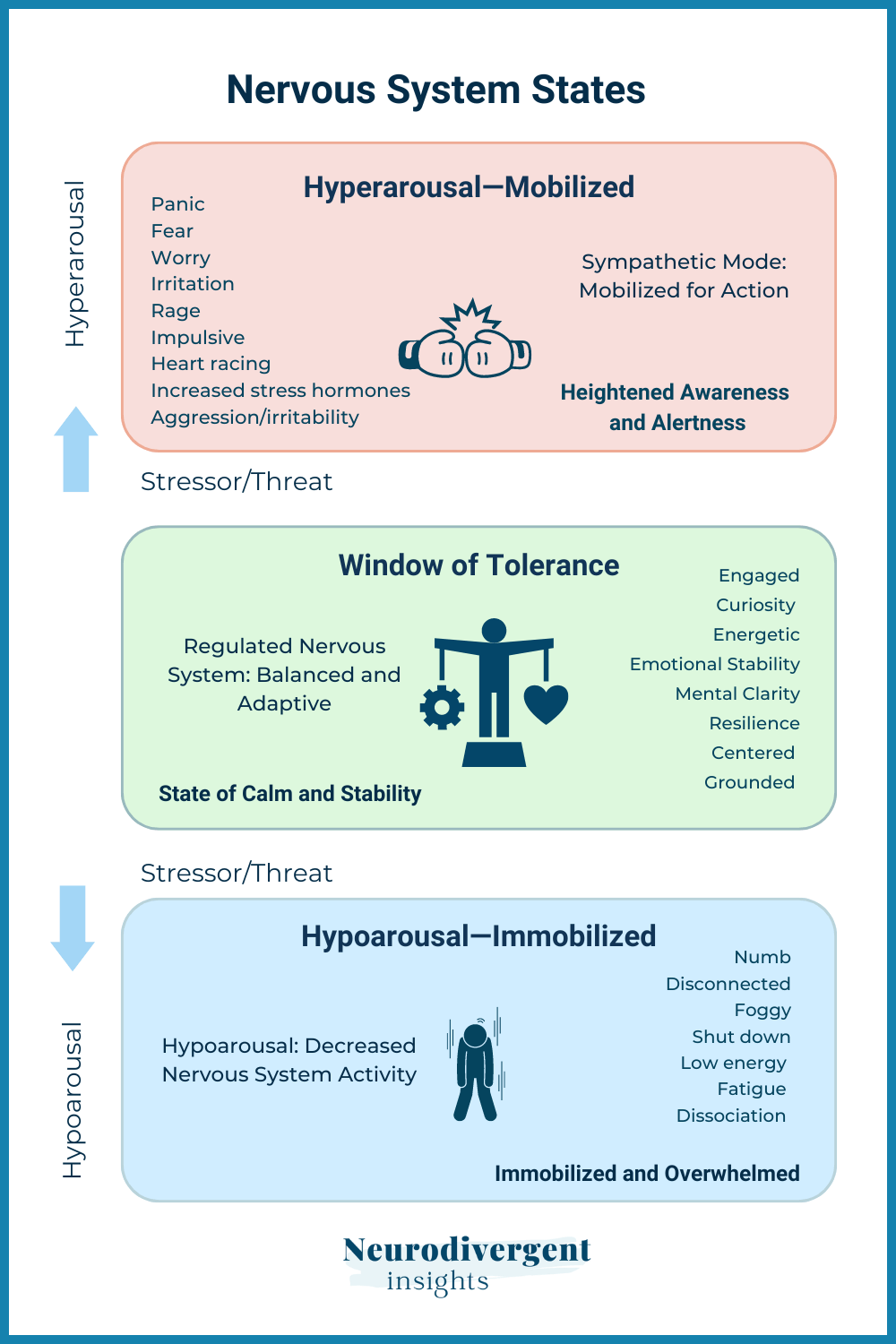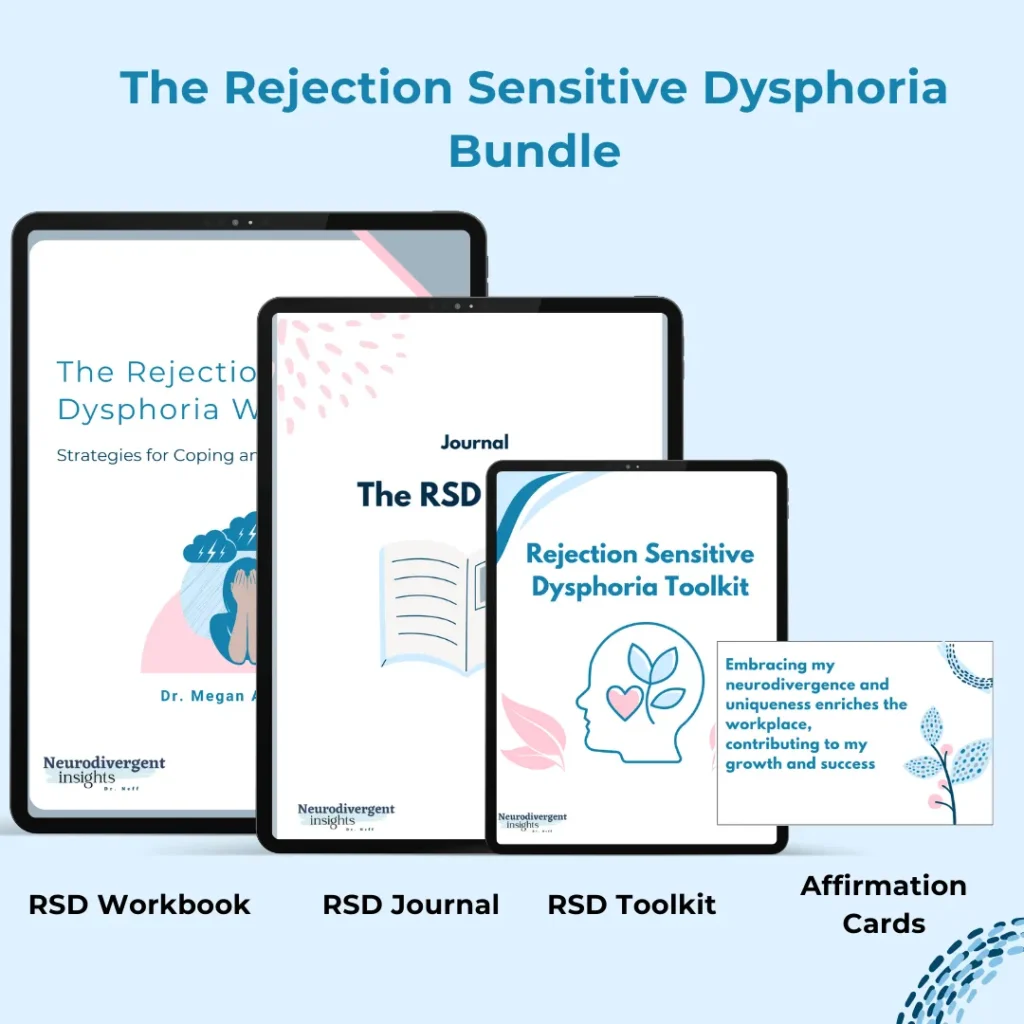
Ever have those days where your energy is all over the place? One moment you’re buzzing with excitement, and the next, you’re completely wiped out. Understanding how to up-regulate and down-regulate your nervous system can help you find that perfect balance.
Maybe you’ve used breathing exercises to calm down when feeling anxious—that’s down-regulation. Or perhaps you’ve taken a brisk walk to shake off tiredness—that’s up-regulation. These are simple techniques to adjust your energy levels, even if they sound a bit technical.
As a psychologist, I’ve seen how understanding the nervous system can empower people. By learning a few key strategies, you can better manage your energy and stress levels. We’ll also touch on Dan Siegel’s concept of the window of tolerance, which is like your nervous system’s comfort zone. When you’re in this zone, you can handle stress more easily. But when stress pushes you out of it, knowing how to regulate your system can make all the difference.
In this post, we’ll explore up-regulation and down-regulation, including how to map your nervous system and expand your window of tolerance. Let’s get started!The Window of Tolerance
The window of tolerance is like the sweet spot of our nervous system, where our emotions and reactions are just right. Think of it like Goldilocks and the three bears – not too hot, not too cold, but just right. When we’re in our window of tolerance, we can think clearly, make decisions, and communicate effectively with others.
We’re in our ideal range of arousal when we’re in our window of tolerance (note in psychology, arousal typically refers to energy and nervous system activation). Plus, it’s where our social brain tends to live, which means we’re able to be present, engaged, and adaptable. It’s kind of like finding the perfect temperature for a shower. Too hot or too cold, and you’re uncomfortable, but just right, and you feel refreshed and relaxed.
Dr. Dan Siegel, a well-known psychiatrist and author, introduced the concept of the Window of Tolerance as a model to help us understand how our nervous system handles stress. According to Siegel, we each have an optimal range of arousal where we can effectively manage and process stress, emotions, and challenges. When we’re within this window, we’re able to think clearly, stay calm, and respond to what’s happening around us. This model helps us recognize when we’re operating within our ideal range and when we might need to upregulate or downregulate to return to it.
When we’re in our window of tolerance, we can more easily roll with the punches life throws our way. This is when our nervous system is balanced, with our sympathetic nervous system (the “fight or flight” side) and our parasympathetic nervous system (the “rest and digest” side) working together smoothly. The bigger this window, the more we can handle without getting overwhelmed.
But when stress pushes us out of that window—whether too high (hyperarousal) or too low (hypoarousal)—it’s like hitting our stress limit. That’s when we start struggling to control our emotions and actions. The good news is there are ways to bring ourselves back into balance. In this post, we’re focusing on how to shift between different states using upregulating and downregulating techniques. This is all about helping our nervous system get the support it needs when things get tough.

How to Identify Dysregulation
Ever feel like you’re constantly on the edge? That could be a sign of nervous system dysregulation, where your body’s arousal levels are off-kilter, making it tough to manage emotions and behaviors. Here are some signs to watch for:
Emotional Ups and Downs: Extreme mood swings or difficulty controlling emotions.
Sleep Issues: Trouble falling or staying asleep.
Impulsivity: Struggling to make decisions or resist impulsive behaviors.
Physical Symptoms: Constant fatigue, irritability, or tension.
Overreactivity: Feeling hyper-sensitive or overreacting to situations.
When dysregulated, we often swing between hyperarousal (feeling overly activated) and hypoarousal (feeling shut down). Next, we’ll dive into these two states and how to recognize them.
Hyperarousal: When Energy Surges
Hyperarousal happens when your nervous system is in overdrive. It’s like your body is stuck in high gear — you’re on high alert, your heart is racing, and it feels almost impossible to relax. This state is connected to our sympathetic nervous system, which is responsible for the fight-or-flight response. When you’re in hyperarousal, everything feels urgent, and it’s hard to wind down or feel at ease.
The Fight-or-Flight Response
The fight-or-flight response is our body’s built-in alarm system, designed to protect us from danger. It’s an ancient mechanism that helped our ancestors survive life-threatening situations, like escaping from predators. However, in today’s world, we often trigger this response in situations that aren’t actually life-threatening—like dealing with a work deadline or having a tough conversation.
That’s where upregulation and downregulation come into play. Upregulation is when our nervous system ramps up to handle stress, which is useful in moments of danger or when we need to meet a deadline. But if we stay in this heightened state for too long, it can lead to chronic stress and other health issues.
While the fight-or-flight response is crucial for survival, it’s equally important to know how to down-regulate and bring your body back to a state of calm once the threat has passed.
Symptoms of Hyperarousal in Fight-or-Flight Mode
When your body is stuck in fight-or-flight mode, your sympathetic nervous system goes into overdrive. This can lead to a whole host of symptoms that can feel overwhelming. You might notice:
Feeling anxious, restless, or irritable
Rapid heartbeat and shortness of breath
Difficulty concentrating or sleeping (insomnia)
Being easily startled or feeling on edge
Physical signs like sweating, headaches, or nausea
Changes in appetite or digestive issues
These are all signs that your body is in a hyperaroused state, trying to protect you from perceived danger. Recognizing these symptoms is the first step toward learning how to down-regulate and bring your nervous system back into balance.
Why Does Hyperarousal Happen?
Hyperarousal can be triggered by a variety of factors, including stress, trauma, and certain medical or mental health conditions. Some conditions tend to push the nervous system into a state of sympathetic dominance, where the “fight-or-flight” response is frequently activated. These include:
PTSD and C-PTSD
Generalized anxiety disorder
Panic disorder
OCD
Social anxiety
Phobias
Borderline personality disorder
Irritable bowel syndrome (IBS)
This list isn’t exhaustive, but it highlights conditions where down-regulation techniques can be especially helpful for bringing the nervous system back into balance. But before we dive into those strategies, let’s explore the other side of the spectrum—hypoarousal.
Hypoarousal: When Energy Levels Drop
If hyperarousal is like having too much gas in the tank, hypoarousal is like running on empty. In this state, your nervous system is under-activated, making you feel sluggish and unmotivated. It’s as if your body is pressing too hard on the brakes and not enough on the gas pedal.
When we’re stuck in hypoarousal, it can be tough to get moving, both physically and mentally. You might notice symptoms like:
Fatigue
Low energy
Difficulty concentrating
Low mood or depression
Sleepiness
Decreased motivation
Slower heart rate and breathing
If you’re experiencing hypoarousal, it’s important to find ways to gently up-regulate your system and bring yourself back into a balanced state.
Understanding Hypoarousal: Feeling Stuck and Disconnected
When someone is in a state of hypoarousal, they might feel sluggish, detached, and disconnected from their surroundings. Concentration and decision-making can become difficult. This state can be triggered by various factors, including depression, trauma, chronic fatigue, or medical conditions like fibromyalgia or chronic pain.
Conditions commonly associated with hypoarousal include:
Chronic fatigue syndrome
Depression
Fibromyalgia
Migraines
Sleep disorders
Chronic pain
Dissociative conditions
It’s important to consult with a healthcare provider to identify any underlying medical issues and better understand what might be contributing to your symptoms.
How to Regulate Your Nervous System
The first step in getting your nervous system back on track is figuring out where you currently are. This process, known as “nervous system mapping,” involves identifying your current state of arousal—whether you’re in hyperarousal, hypoarousal, or within your window of tolerance. By regularly checking in with yourself, you can better understand your nervous system’s patterns and learn what strategies help you stay balanced.
Nervous System Mapping
Think of your nervous system like a rollercoaster, with different levels corresponding to different states of arousal—whether you’re on high alert at the top, calm and collected in the middle, or sluggish and shut down at the bottom. The idea behind nervous system mapping is to pinpoint where you are on this rollercoaster at any given moment.
By doing this, you can figure out whether you need to upregulate (bring yourself up) or downregulate (calm yourself down) to get back into your “window of tolerance”—that ideal state where you can handle life’s challenges most effectively. This practice can help you become more aware of your body’s responses and give you the tools to stay balanced.

How to Practice Nervous System Mapping
Nervous system mapping can be done anywhere, but it’s helpful to start practicing in a calm and safe environment. Here’s a simple guide:
Breathe: Take a deep breath in through your nose and out through your mouth.
Body Scan: Bring your awareness to your body, starting from your head and moving down to your toes. Notice any areas of tension or discomfort.
Breath Awareness: Pay attention to your breath; is it shallow or deep? Fast or slow?
Mind Check: Notice your thoughts; are they racing, calm, or absent?
Label Your State: Try to label where you are—upregulated, downregulated, or within your window of tolerance.
Take Action: If you’re outside your window of tolerance, try to bring yourself back into balance using various tools. For downregulation, consider deep breathing, progressive muscle relaxation, or grounding exercises. If you’re feeling hypoaroused and need to upregulate, try brisk movement, engaging in a stimulating activity, or even energizing music to bring yourself back into a more balanced state. By practicing these techniques regularly, you’ll be better equipped to manage your nervous system and stay within your optimal range.
When practicing nervous system mapping, it’s crucial to pay attention to what your body is telling you. Don’t push yourself into exercises that don’t feel safe. This practice is all about self-awareness, not forcing change. Over time, you’ll become more attuned to your body’s signals and better able to regulate your nervous system.
If you struggle with interoceptive awareness or alexithymia, it might help to start by sitting down and mapping out the common thoughts, behaviors, and sensations you experience in different nervous system states. This preparation can make live-time mapping easier. For guidance, consider using resources like a nervous system mapping handout, which you can find in our sources like a nervous system mapping handout, which you can find in our nervous system workbook

Nervous System State Shifting
Once you’ve pinpointed where you are in your nervous system, the next step is to shift it back to that “sweet spot” — your window of tolerance. This process is known as “nervous system state shifting,” and it’s all about learning to adjust your energy levels to better match your needs.
Upregulating is like stepping on the gas when you need more energy and focus. It’s useful for moments that require alertness, like before a presentation or tackling a big project. Activities like exercising, listening to energizing music, or anything that gets your blood pumping are great ways to upregulate your system.
Downregulating is about tapping the brakes to lower your arousal and bring a sense of calm. This is helpful when you need to relax, whether before bedtime or during a stressful moment. Techniques like deep breathing, meditation, yoga, or calming music can help downregulate your nervous system.
Each time you successfully shift your nervous system back into your window of tolerance, you’re helping to reinforce your body’s ability to self-regulate. Over time, consistently practicing these regulation techniques can contribute to improved vagal tone, which is associated with better overall health, resilience to stress, and emotional well-being. While it’s not an instant effect, these practices gradually strengthen your nervous system’s capacity to manage stress more effectively.
How to Up Regulate
When you’re feeling sluggish, unmotivated, or stuck in a low-energy state, it might be a sign that your nervous system is in a state of hypoarousal. This means your energy levels are low, and you may feel disconnected or fatigued. Upregulating is about boosting your energy and bringing yourself back to a more alert and engaged state.
If you want to give your nervous system a boost, here are a few strategies that can help you upregulate:
Physical Movement: Exercise, even a short burst of activity, can increase your heart rate and boost energy levels. Try a brisk walk, dancing, or even some jumping jacks.
Cold Exposure: A splash of cold water on your face or a brief cold shower can activate your nervous system and increase alertness.
3. Breathwork: Rapid, shallow breathing exercises (like the “breath of fire” in yoga) can stimulate your nervous system and wake you up.
4. Stimulating Environment: Change your surroundings—turn on bright lights, listen to upbeat music, or step outside into fresh air to invigorate your senses.
5.Engage Your Mind: Challenge your brain with a quick puzzle, a stimulating conversation, or a task that requires focus. This can help shift your nervous system into a more activated state.
6.Use Sensory Input: Grab a fizzy or cold drink, gently sway or rock, or use alerting sensory inputs to awaken your body.
The goal is to gently wake up your nervous system and to find the right balance—upregulation should bring you into a state of alertness and engagement without tipping you into hyperarousal.
How to Down Regulate
If you’re constantly feeling on edge, like you’re teetering on the brink of a meltdown, it might be time to focus on calming your nervous system. Hyperarousal happens when our bodies are stuck in “fight-or-flight” mode for too long, leaving us in overdrive.
Down-regulation helps bring your body and mind back to balance. It encourages the release of calming neurotransmitters like GABA and reduces stress hormones like cortisol. Here are some techniques to try:
Deep Breathing: Slow, deep breaths activate the relaxation response, slowing your heart rate and reducing tension in your body.
Mindfulness Meditation: By focusing on the present moment, mindfulness helps reduce stress by calming your mind and preventing anxious thoughts from spiraling.

3.Guided Imagery: Visualizing peaceful scenes helps your brain shift from stress to calm, reducing physical and emotional tension.
4.Tapping (EFT): This technique involves tapping specific points on your body to release pent-up stress, helping to calm both the mind and body.
5.Progressive Muscle Relaxation: Tensing and then relaxing muscle groups helps release physical tension, sending signals to your brain to calm down. You can find a free audio guide here at Darmouth’s wellness center.
6.Calming Music: Soothing music can promote the production of delta waves, associated with deep relaxation and reduced anxiety.
7.Binaural Beats: These audio tones can help synchronize your brainwaves to a more relaxed state, easing stress and tension.
8.Nature: Spending time in nature naturally lowers stress levels, helping you feel more grounded and at ease.

9.Self-Care: Activities like taking a warm bath or reading a good book nourish your body and mind, helping to bring you back to balance.
10.Yoga and Tai Chi: These gentle practices combine movement with breath, promoting relaxation by stimulating the parasympathetic nervous system. Poses that get your head below your heart can quickly activate the body’s relaxation response.
Each of these strategies helps regulate your nervous system, bringing you back into your window of tolerance where you can better handle life’s challenges.
Wrapping It All Up: Up and Down-Regulation
Upregulation and downregulation are all about finding the right balance for your nervous system. When you’re feeling sluggish, it’s a signal to upregulate—get moving, engage in stimulating activities, or try some energizing breathwork. On the flip side, if you’re anxious or stressed, downregulating through deep breathing, meditation, or other calming practices can bring you back to a state of balance.
Understanding your window of tolerance helps you know when it’s time to shift gears. By learning to regulate your nervous system, you can boost your overall well-being and resilience.
References
Beutler, S., Mertens, Y. L., Ladner, L., Schellong, J., Croy, I., & Daniels, J. K. (2022). Trauma-related dissociation and the autonomic nervous system: a systematic literature review of psychophysiological correlates of dissociative experiencing in PTSD patients. European Journal of Psychotraumatology, 13(2).
Corrigan, F. M., Fisher, J. J., & Nutt, D. J. (2011). Autonomic dysregulation and the window of tolerance model of the effects of complex emotional trauma. Journal of psychopharmacology, 25(1), 17-25.
Siegel, D. J. (2010). The Mindful Therapist: A Clinician’s Guide to Mindsight and Neural Integration (Norton Series on Interpersonal Neurobiology). WW Norton & Company.









